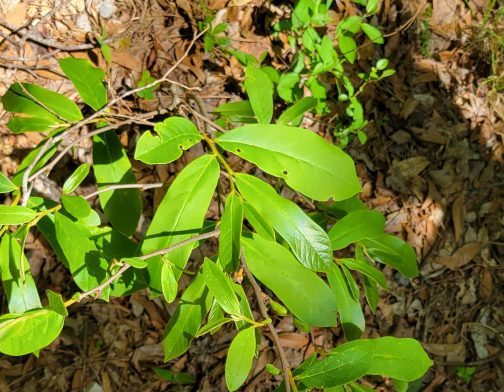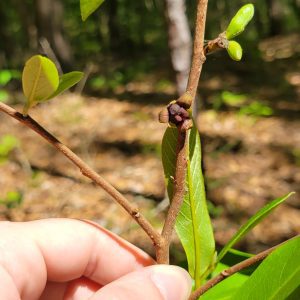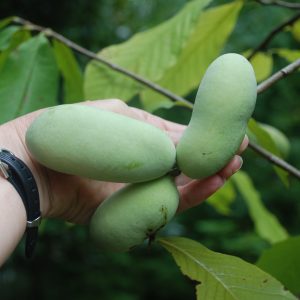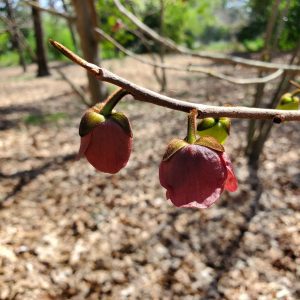Forestry

Pawpaw is an intriguing native fruit in the custard apple family. Most members of the family are tropical, but there are a handful of native species that live in Alabama and beyond. Two of the species found in the state, common pawpaw (Asimina triloba) and small flower pawpaw (Asimina parvifolia), have notable fruiting potential.
Common Pawpaw
General Description
Common pawpaw (Asimina triloba) is a large shrub or small tree found across most of Alabama, with greater populations found in the northern half of the state. Depending on conditions, it can range from 3 feet in height to as tall as 30 feet and can form spreading thickets from root sprouts. In the wild, it tends to grow in wet soils near streams or other bodies of water and can tolerate considerable shade. It has large leaves (approximately 10 inches in length and approximately 4 inches wide) that are fuzzy when young but become smooth with age. When crushed, the leaves have a strong odor reminiscent of bell pepper. The growth form is relatively open, and the bark stays tight and thin, even on older trees. The flowers, which develop before or with the leaves, are 1 to 2 inches across and reddish purple to maroon in color. Flowers have a somewhat unpleasant odor that attracts the flies and carrion beetles necessary for successful pollination. The fruit is the largest of any native North American plant, reaching 3 to 5 inches long. When ripe in mid-to late-summer, the fruit is greenish or yellowish in color with mottled brown areas. The foliage turns yellow in the fall.
- Flower
- Fruit
- Common Pawpaw Flower
Uses for People
The large fruit of common pawpaw has been consumed by humans for thousands of years, and Native Americans spread the tree widely for both the fruit and fibers that can be obtained from its bark. The ripe fruit has a custard-like texture–not unlike a soft banana–and has been compared in flavor to banana, strawberry, mango, or cantaloupe, depending on the source tree or cultivar. The fruit does not ship or store well, ripening quickly when off of the tree and bruising easily. This has limited commercial production and sale. Fruit can be dried or frozen and mixed into ice cream and other recipes and is also excellent eaten fresh off the tree or chilled. Care should be taken to avoid the large seeds. It also has some use in the landscape. The spreading form of the tree and its tropical looking foliage can make it suitable for use as a green screen during the summer, and the vibrant yellow autumn foliage can add visual interest.
Preparations
The best way to enjoy pawpaw fruit is to consume it raw. Selecting ripe fruits can be done by gently squeezing the outside. An underripe pawpaw fruit will feel more like an apple but a ripened fruit will have a soft touch like a ripened peach or banana. The pawpaw fruit can be stored at room temperature or in a refrigerator, but refrigeration will extend the fruit’s shelf life. Freezing is the best preservation method for nutritional content retention. They can be frozen whole, chopped, or pureed. For chopping fruit, arrange in a single layer on a baking sheet and place in freezer for one to two hours depending on the size of the cuts. Once frozen, transfer to a freezer bag labeled with the contents and packing date.
The pawpaw fruit is nutrient dense. They are high in vitamins, minerals, and amino acids. According to the KSU Pawpaw Research Project, the pawpaw fruit has three times as much vitamin C as an apple and twice as much potassium as an orange. For more nutritional information, see Kentucky State University’s Pawpaw Description and Nutritional Information at www.kysu.edu.
Uses for Wildlife
Many species of wildlife readily consume pawpaw fruit, and the foliage can offer shade and shelter for many animals and nesting birds. The foliage is consumed by zebra swallowtails as one of their only host plants.
Cultivation
Common pawpaw can be grown across the state, provided it is planted on an appropriate site. It may fail to thrive if it is planted where salt air is an issue, but it has been grown in the far southern regions with success. The young trees are remarkably shade tolerant and may be burned by excessive sun, but larger trees will produce better in full sun conditions. The trees need to be planted in rich, well-draining soil with plenty of available moisture. A variety of higher-yielding and larger-fruited cultivars are available online or from native plant nurseries. If allowed to sucker, it will grow into a spreading thicket. Suckers should be removed if a more tree-like growth form is desired. Removed suckers can be used to propagate additional trees. To ensure good pollination and yield, it is recommended that multiple varieties be planted in close proximity (less than 30 feet). Some people place compost bins or other fly attractants near trees to improve pollination.
When plants from good stock are planted on an appropriate site pawpaw is remarkably pest and disease resistant. Pawpaw is also deer resistant and experiences almost no pressure from deer under normal conditions. That said, many animals will smell the fruit and seek it out as it ripens, so netting or other deterrents may be needed during the ripening period.
Small Flower Pawpaw
General Description
Small flower pawpaw is similar in many ways to the common pawpaw. A spreading small- to medium-sized shrub, it is found across the state, often on drier sites than its larger cousin. On particularly dry sites, it may remain only 1 foot or so tall, though in better conditions it can grow as tall as 10 feet. The leaves and flowers are smaller than those of common pawpaw but otherwise similar in appearance. Likewise, while the fruit is comparable in appearance and flavor, it is smaller in size (less than 3 inches).
Uses for People
The fruit can be excellent and may be used similarly to fruit of common pawpaw. However, in poor conditions, the fruit can be seedy and have poor flavor. Small flower pawpaw can also be used as spreading ground cover in partially shaded areas.
Uses for Wildlife
The fruit is consumed by many species, and like the common pawpaw, it is a host for the zebra swallowtail butterfly.
Cultivation
Small flower pawpaw can be grown in a wide variety of sites and soil types. It can grow in xeric, sandy soils or in more fertile bottomland conditions. It is less available than common pawpaw but can be found online or from specialty nurseries. Higher-yielding cultivars are not yet available. Multiple individuals planted in good conditions can yield plentiful fruit. However, with its smaller size and more spreading habit, it may serve better as a wildlife plant than as a major source of fruit if common pawpaw can be grown instead. This is particularly true in conditions where fruit quality may be lower. It is free from pests and disease pressure under most circumstances.
Recipes
Learn more about using pawpaw or cooking with pawapaw fruits from Kentucky State University.




